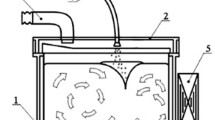It is known that the main factor specifying the dispersity of spraying of particles of metallic powders is the energy of blowing, which is, as a rule, controlled by the speed of supply of gaseous energy carrier to the jet of the melt. We study the modes of manufacturing and, on the basis of the results of computer simulation, develop special tooling for the procedure of dispersion of powders of solder aluminum alloys. We consider technical and technological schemes of getting powders from aluminum alloys intended for soldering the waveguides. The computer investigations of the influence of the geometry of structural elements of equipment on the parameters of dispersion of the AK12Ts10 melt are carried out by using the Solidworks Flow Simulation package for engineering analysis. In this case, it is assumed that the speed of the gas (argon) jet at a temperature of 20°С at the site of collision with the melt must be maximum for the identical other conditions (initial pressure, gas temperature, and temperature of the melt). We establish the dependences necessary and sufficient for the design of structural elements of the equipment and the creation of technological modes guaranteeing the realization of conditions of stability of the process of dispersion of the metal melt in getting powder of the required fraction (70 μm) in a laboratory installation. We present a description of the installation intended for the dispersion of AK12Ts10 melts with the help of which we prepared a pilot batch of a powder fraction 70 μm in size with a mass of 400 g. This batch was then delivered to the Reshetnev “Information Satellite Systems” Enterprise for industrial tests aimed at soldering aluminum waveguides. The tests of the paste in the course of soldering of elements of the waveguides under industrial conditions exhibited positive results.






Similar content being viewed by others
References
G. N. Smirnov, Advanced Methods of Soldering of Aluminum [in Russian], Metallurgiya, Moscow (1981).
V. M. Balashov, E. G. Semenova and N. A. Trefilov, Technology of Manufacturing of the Antennas and SHF Devices [in Russian], Mir Knigi, Moscow (1992).
E. I. Storchai, Flux Soldering of Aluminum [in Russian], Metallurgiya, Moscow (1980).
N. N. Nikitinskii, Soldering of Aluminum Alloys [in Russian], Mashinostroenie, Moscow (1983).
V. M. Balashov, E. G. Semenova, and. L. Ch. Tszyun,’ “Resource-saving technologies of high-temperature soldering of antenna structures of complex geometry in electric furnaces,” in: Proc. of the 4th All-Russian Conf. “Radiolocation and Radiocommunication” (Institute of Radioelectronics, Russian Academy of Sciences, 29.11–03.12.2010) [in Russian], Moscow (2010), pp. 826–839.
V. M. Balashov and A. V. Zhuk, Technology of High-Temperature Soldering of Slotted Waveguide Antennas in Salt Melts [in Russian], St. Petersburg State Electrotechnical University (Leningrad Electrotechnical Institute), St. Petersburg (2006).
V. M. Balashov, A. A. Kaplunov, N. P. Makarova, and I. N. Pashkov, “Powder solders for resource-saving technologies of hightemperature soldering of waveguide structures of complex profiles,” Vopr. Radioélektron., Ser. Obshchetekhnicheskaya, Issue 3, 89–98 (2009).
V. M. Balashov, A. A. Kaplunov, N. P. Makarova, and I. N. Pashkov, “High-temperature solder pastes for soldering of waveguide structures of complex profiles,” Vopr. Radioélektron. Ser. Obshchetekhnicheskaya, Issue 3, 98–107 (2009).
Yu. V. Gorokhov, S. V. Belyaev, I. V. Uskov, I. L. Konstantinov, I. Yu. Gubanov, T. Yu. Gorokhova, and P. A. Khramtsov, “Application of combined casting–pressing for the fabrication of aluminum wire for soldering waveguides,” Izv. Vyssh. Uchebn. Zaved., Tsvet. Metallurg., No. 6, 65–70 (2016); English translation: Russ. J. Non-Ferr. Met., 58, Issue 1, 75–79 (2017).
A. P. Smiryagin, N. A. Smiryagina, and A. V. Belova, Commercial Nonferrous Metals and Alloys [in Russian], Metallurgiya, Moscow (1974).
M. V. Mal’tsev, Metallography of Nonferrous Metals and Alloys [in Russian], Metallurgiya, Moscow (1970).
B. B. Gulyaev, S. M. Petrov, S. G. Petrova, and A. A. Abramova, Synthesis of High-Strength Silumins [in Russian], Leningrad State University, Leningrad (1978).
B. B. Gulyaev and V. T. Senchenko, “Relationship between the parameters of diagrams of state and the casting properties of alloys,” in: B. B. Gulyaev (editor), Properties of Molten Metals [in Russian], Nauka, Moscow (1974), pp. 125–131.
N. V. Ageev (editor), Diagrams of State of Metallic Systems (Collections of Works of the All-Union Institute of Scientific and Technical Information) [in Russian], State Committee on Science and Engineering, Academy of Sciences of the SSSR, Moscow (1955–1980).
A. A. Alyamovskii, Solid Works Simulation. How to Solve Practical Problems [in Russian], BKhV-Peterburg, St. Petersburg (2012).
TU 1-30857–2015. PASVISS (Solder Aluminum Alloy Produced by the ISS) [in Russian], Reshetnev “Information Satellite Systems” (ISS, Moscow).
Author information
Authors and Affiliations
Corresponding author
Additional information
Translated from Metallurg, Vol. 62, No. 6, pp. 96–99, May 2018.
Rights and permissions
About this article
Cite this article
Uskov, I.V., Gorokhov, Y.V., Gubanov, I.Y. et al. Development of Tooling and Modes of Dispersion for Powders of Solder Aluminum Alloys. Metallurgist 62, 597–602 (2018). https://doi.org/10.1007/s11015-018-0697-8
Received:
Published:
Issue Date:
DOI: https://doi.org/10.1007/s11015-018-0697-8




